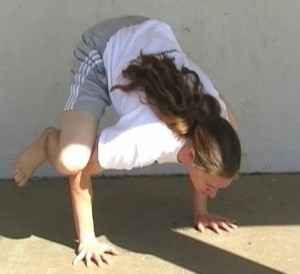The problem with the freestanding handstand is that it is too hard a skill for most people to jump right into. Maybe you have experience doing them against the wall, but even that is not enough to start balancing out in the open.
I know! I took the long road, falling over so many times, while just inching along in my ability to do the handstand.
But there is a better way. Instead of kicking up into a handstand and hoping you’ll be able to stay in it for more than three seconds you can take a more systematic approach.
There are certain skills that work to build the component parts of doing a handstand, yet are easier than the handstand itself to progress in and master.
In the article you’ll find out what those skills are, how to do them, and how they’ll help you with the eventual goal of hitting the handstand.
Handstand Against the Wall - Kickup into a handstand against the wall. Make sure your arms are locked out and you are pushing yourself away from the ground. This creates a locked out feel and makes this position rely on your bone structure more than your muscles. The wall handstand gets you use to the position of the handstand. It also builds strength and endurance.
Frogstand - Squat down on the ground. Place your hands shoulder width apart on the floor. With the elbows bent place your knees on the outside back of them. Begin to tip forward until you find yourself in a balance.

The frogstand gets you use to controlling your balance with your hands. This much needed skill allows you to go from over or under balancing and back to a stable position. As the frogstand is low to the ground it is much easier than the handstand.
Headstand - Place your head on the floor with your hands a little in advance of your face, forming a triangle or tripod. Jump or raise you legs up until they are overhead. Be prepared to roll out of position if you overbalance. And if you’ve never done this before you may want to try it against the wall before going out in the open.
The headstand teaches you to balance your body in the air, while taking the arms and hands out of the equation. Again it is easier than the handstand as you are lower to the ground and have a wider base of support.
These three moves are integral in teaching you what you need to learn in order to do a freestanding handstand. By practicing these skills and being able to hold them easily and consistently you‘ll be much better off when you start your work on the handstand.
There are other lead-up stunts as well as important factors in learning the handstand.
I’ve just released a 30 minute handstand system video on my site, http://www.lostartofhandbalancing.com, that is available for free for a limited time.

1 comment:
Actually I need a real one because I'm practicing parkour and it's very useful to have one.
Thanks anyway, good luck.
Post a Comment